Marigolds might look like simple garden favorites with their vibrant orange and yellow blooms, but they’re hiding an incredible secret weapon that savvy gardeners have utilized for centuries. These unassuming flowers pack a powerful punch against pests, soil-borne diseases, and even certain nematodes through compounds naturally present in their roots, stems, and flowers.
We’ve discovered that marigolds’ secret lies in the release of alpha-terthienyl and other sulfur compounds that act as natural pesticides. When strategically planted throughout your garden, they create an invisible shield protecting your precious vegetables and ornamentals. It’s no wonder companion planting with marigolds has been passed down through generations of green thumbs who understand the immense value behind these seemingly decorative blooms.
The Hidden Powers of Marigolds: Nature’s Secret Weapon in Gardening
Marigolds possess remarkable capabilities that extend far beyond their ornamental value in gardens. These bright flowers contain potent biochemical compounds that actively fight against common garden problems. Many experienced gardeners consider marigolds essential plants rather than merely decorative additions.
The sulfur compounds in marigolds effectively repel many insect pests including aphids, whiteflies, and mosquitoes. Their strong scent masks the smell of neighboring plants, confusing pests that rely on odor to locate their preferred hosts. Scientists have identified alpha-terthienyl as the primary compound responsible for marigolds’ nematode-fighting properties.
Root systems of marigolds release biofumigants that cleanse soil of harmful pathogens and nematodes. When incorporated into garden beds as a cover crop, these flowers can reduce nematode populations by up to 90% in just one growing season. Planting marigolds in rotation with vegetables creates healthier soil conditions for future crops.
We’ve found that marigolds attract beneficial insects such as ladybugs, hoverflies, and parasitic wasps that prey on garden pests. Their bright orange and yellow blooms serve as landing pads for pollinators including bees and butterflies. Most varieties of marigolds bloom continuously from spring until first frost, providing season-long benefits.
Companion planting with marigolds protects tomatoes from hornworms, keeps bean plants free of Mexican bean beetles, and shields cabbage from many pests. Their roots exude chemicals that deter harmful soil fungi, including those causing root rot and damping-off disease. French marigold varieties (Tagetes patula) typically offer the strongest pest-repelling properties compared to other types.
How Marigolds Act as Natural Pest Repellents in Your Garden
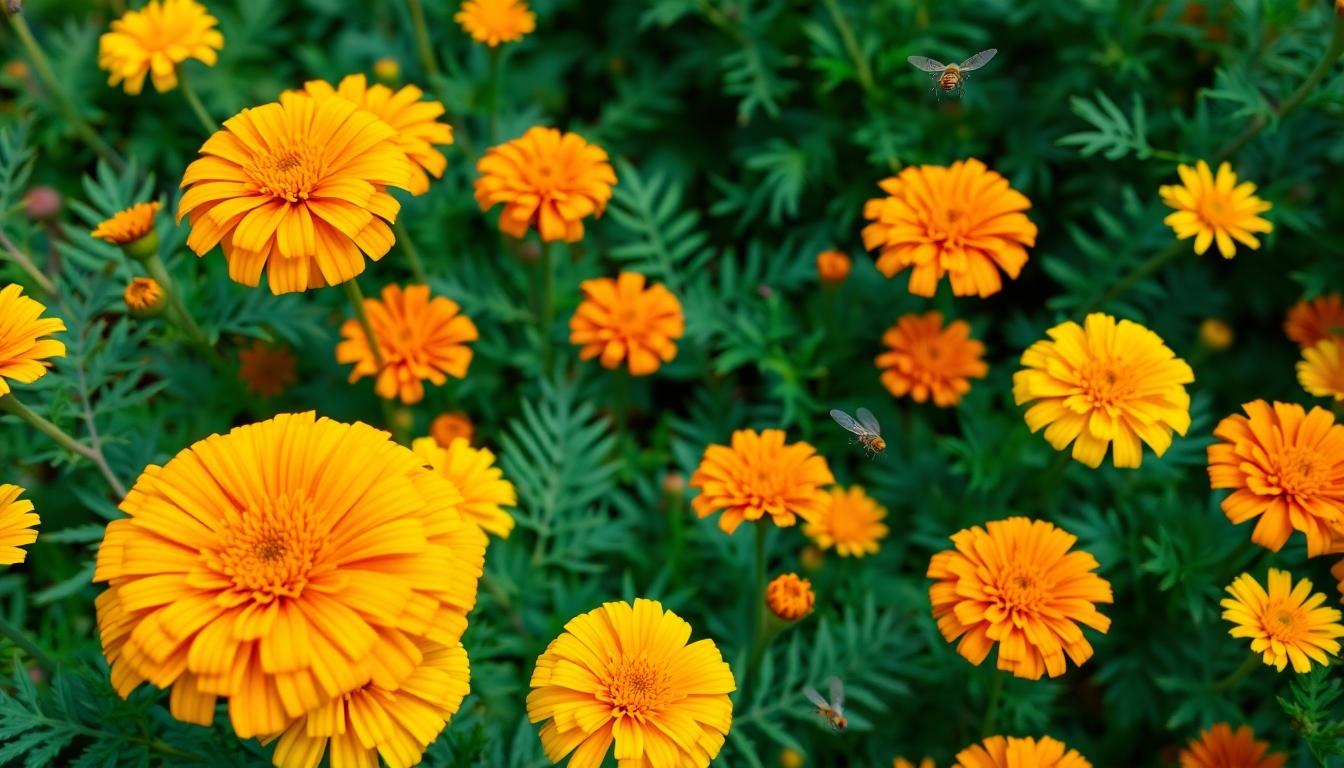
Marigolds work tirelessly as natural guardians in your garden through multiple pest-fighting mechanisms. These vibrant flowers deploy powerful chemical defenses both above and below ground to protect your precious plants.
Nematode Control: Marigolds’ Underground Defense System
Marigolds effectively combat root-knot nematodes (Meloidogyne spp.) by secreting alpha-terthienyl compounds from their roots. These natural chemicals specifically target nematode reproduction by inhibiting egg development, creating an inhospitable environment for these destructive soil-dwelling pests. Gardeners can maximize this benefit by planting marigolds as a preparatory crop before introducing vulnerable plants to the area. This proactive approach prevents nematode population buildup in the soil and provides lasting protection throughout the growing season. Research shows that using marigolds as a cover crop can dramatically reduce nematode infestations, offering a chemical-free solution to this common garden problem.
Repelling Aphids, Whiteflies, and Other Common Garden Pests
Marigolds emit a distinctive aroma that acts as a powerful deterrent against many garden pests. The thiophene essential oils produced by marigold plants naturally repel aphids, whiteflies, blackflies, mosquitoes, and wasps without requiring any additional intervention. Strategic placement of marigolds creates an effective perimeter defense system for your garden. Placing these flowers densely around garden borders or interspersing them between vulnerable crops enhances their effectiveness as living insect repellents. Many gardeners plant marigolds specifically to protect high-value crops like tomatoes, strawberries, roses, and squash from pest damage. Marigolds also attract beneficial insects that prey on harmful pests, creating a natural network that maintains balance in your garden spaces.
Companion Planting: Strategic Uses of Marigolds to Protect Other Plants
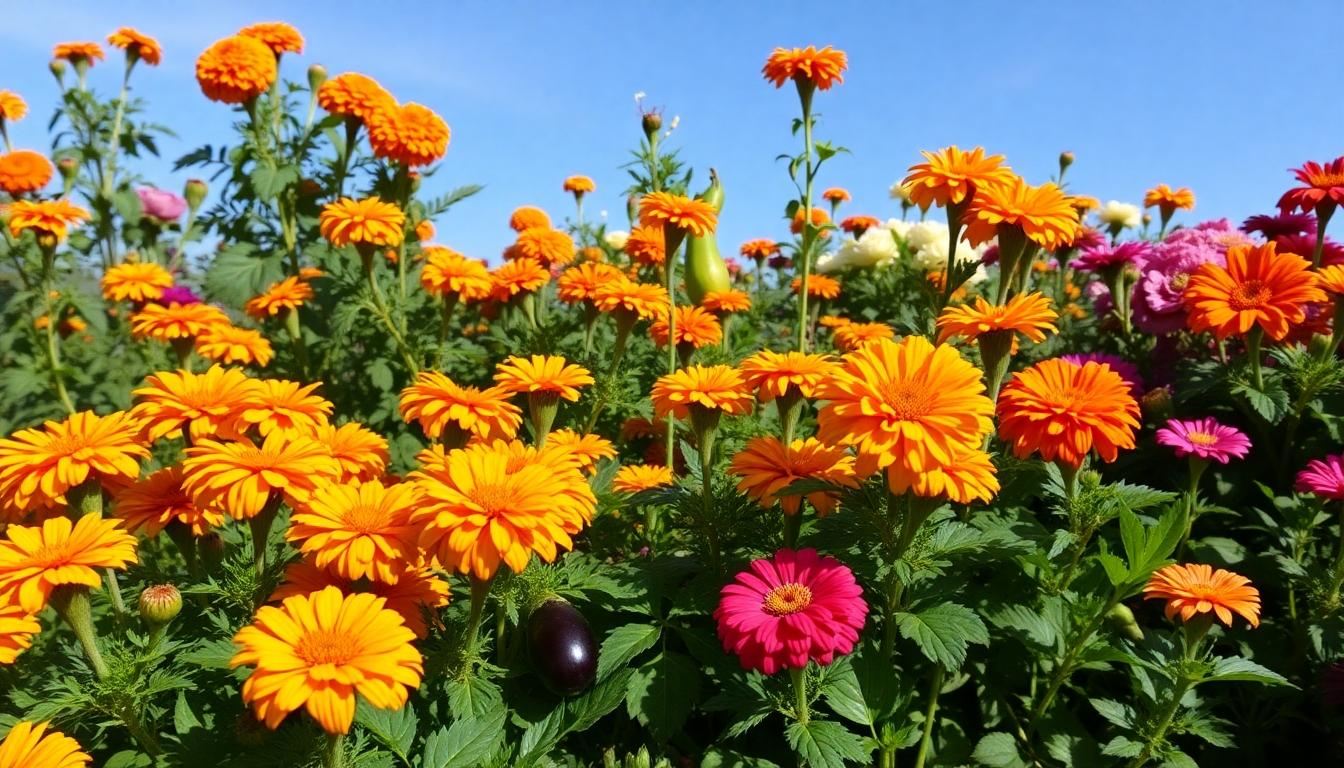
Marigolds serve as natural guardians in the garden through multiple pest-deterring mechanisms. They emit limonene, a volatile compound that actively repels harmful insects, while their strong scent effectively masks the odors of nearby crops.
Vegetables That Thrive When Planted Near Marigolds
Tomatoes gain important protection when interplanted with marigolds throughout the growing season. Research confirms that French marigolds slow whitefly population growth on tomatoes, though it’s worth noting that emergency planting after an infestation has already occurred proves less effective. Cucumbers and eggplants benefit substantially from marigold companions, enjoying reduced pest pressure while attracting more beneficial pollinators to increase fruit production. Squash plants develop stronger resistance to common garden pests when surrounded by these bright orange and yellow guardians. Potatoes experience fewer soil-borne disease issues when marigolds are planted nearby, thanks to the natural biofumigant qualities in marigold roots. Leafy greens like lettuce receive excellent protection from soil-dwelling pests through the root exudates that marigolds release into the surrounding soil.
Flowers That Benefit From Marigold Companionship
Allium varieties, including ornamental and edible types, thrive alongside marigolds which help deter aphids and beetles while conserving valuable soil moisture. Roses display fewer pest problems and often produce more vibrant blooms when marigolds are planted at their bases as natural pest guards. Lavender partners beautifully with marigolds, creating a powerful aromatic combination that confuses and repels many common garden pests. Zinnias and gerbera daisies form striking visual displays when planted with marigolds, as their complementary colors (orange/yellow with purple/blue) enhance garden aesthetics while simultaneously attracting more pollinators. Coreopsis and lantana make excellent drought-tolerant companions for marigolds, sharing their preference for full sun exposure and well-drained soil conditions. French marigolds deliver the most potent pest resistance when strategically placed near the root zones of valuable garden plants, creating an underground defense system against harmful nematodes and soil pathogens.
The Medicinal Properties of Marigolds You Never Knew About

Marigolds aren’t just garden defenders—they’re powerful medicinal allies with scientifically proven health benefits. These vibrant flowers have been utilized for centuries in traditional medicine across various cultures.
Skin Healing and Anti-Inflammatory Benefits
Marigold varieties like Calendula officinalis demonstrate remarkable wound-healing capabilities that make them valuable for skin care applications. Studies confirm that calendula extracts significantly enhance skin hydration and firmness, creating an ideal environment for tissue repair. Tagetes patula marigolds contain potent flavonoids such as quercetin that effectively neutralize reactive oxygen species, reducing cellular oxidative stress and preventing premature cell death. These compounds boost the production of interleukin-10, an anti-inflammatory cytokine that naturally calms inflammatory responses in the body. Calendula’s impressive antimicrobial properties make it particularly effective for treating burns, wounds, and various skin infections. Research has also shown that marigold extracts can successfully reduce ocular inflammation, proving beneficial in cases of conjunctivitis.
Digestive Health and Immune System Support
Marigolds have traditionally served as remedies for many digestive ailments including stomach ulcers, jaundice, and liver problems. The sap from calendula marigolds shows promising metabolic benefits in scientific studies, reducing both blood sugar and cholesterol levels in animal research. Researchers have also noted potential antitumor effects from these golden blooms, though more human studies are needed. The anti-inflammatory mechanisms in marigolds indirectly support immune function by decreasing stress on metabolic systems throughout the body. Polysaccharides and flavonoids found abundantly in marigold flowers contribute significantly to the body’s antioxidative defense network, offering systemic protection against damaging oxidative processes. These compounds work synergistically to neutralize free radicals and support overall cellular health, positioning marigolds as valuable allies for maintaining well-being beyond their garden benefits.
Marigolds as Powerful Soil Conditioners and Bioremediators

Marigolds serve as nature’s unsung heroes for soil health, working diligently beneath the surface to transform and revitalize garden beds. Their contributions to soil conditioning go far beyond their vibrant blooms, offering gardeners a natural solution to improve growing conditions.
How Marigolds Clean Up Contaminated Soil
Marigolds contribute to soil improvement through their unique biological functions, though they aren’t traditional bioremediators. Their presence in gardens creates favorable conditions that support natural soil rehabilitation processes. While exact plants known as hyperaccumulators are more commonly associated with cleaning contaminated soil, marigolds play a supportive role in overall soil health restoration. These colorful flowers enhance the soil environment, making it more conducive for beneficial microorganisms that aid in natural soil cleansing processes. After completing their growth cycle, marigolds can be turned into the soil as green manure, enriching it with organic matter and reducing dependency on synthetic fertilizers. Their ability to manage harmful nematode populations indirectly helps maintain cleaner, healthier soil for future plantings.
Improving Soil Health Through Marigold Root Systems
Marigold root systems deliver remarkable benefits to soil structure and composition in multiple ways. Their deep roots effectively aerate compacted soil, creating channels that improve water infiltration and drainage, particularly in heavy clay soils that tend to become waterlogged. Intercropping with marigolds increases soil moisture retention and boosts nitrogen levels, two critical factors for plant health and productivity. Soil enzyme activities also increase in the presence of marigolds, contributing to more efficient nutrient cycling and availability. Their root networks physically improve soil structure, breaking up compacted layers and creating a more hospitable environment for beneficial soil organisms. We’ve found that incorporating marigolds into garden rotation plans can significantly enhance overall soil health, preparing beds for future plantings with minimal chemical interventions. Their dual action of soil improvement and pest suppression makes them invaluable allies for sustainable gardening practices.
Culinary Uses of Marigolds: From Garden to Table
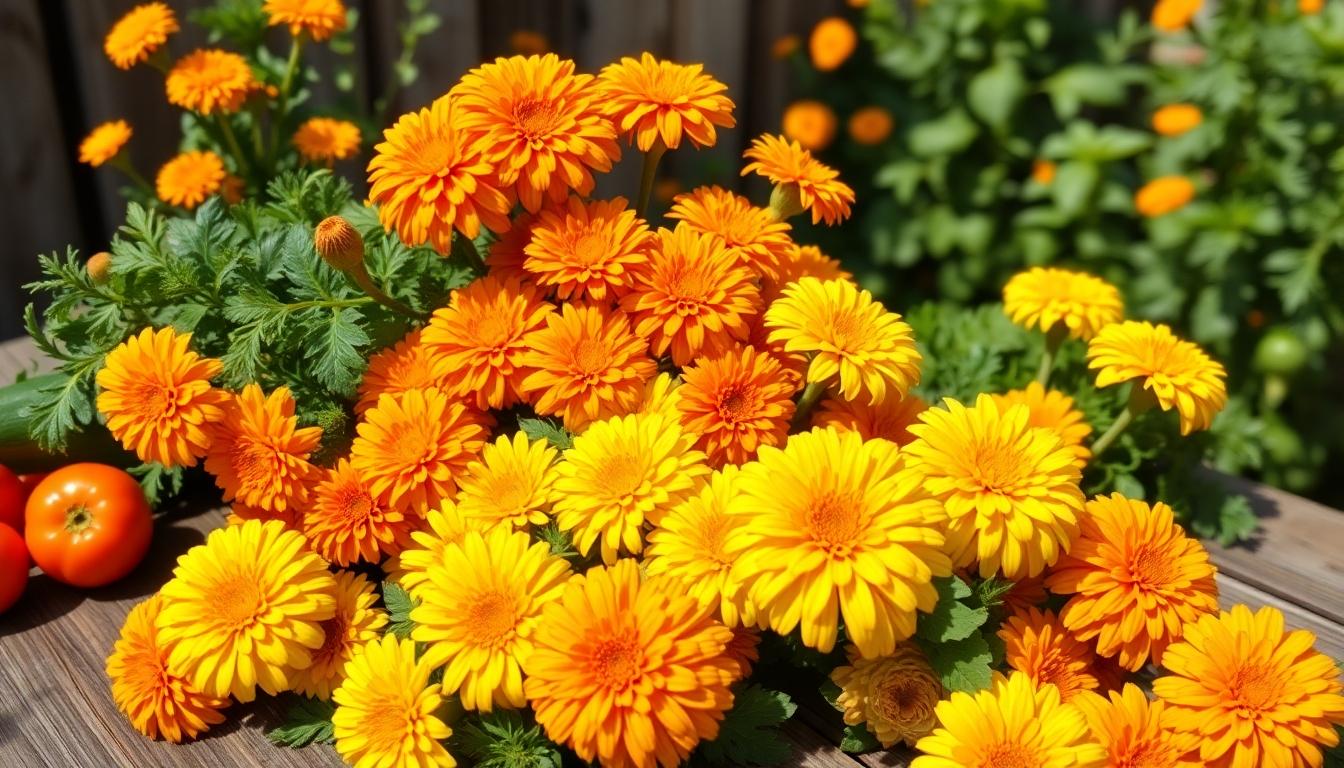
Marigolds aren’t just garden defenders – they’re also delicious additions to your kitchen repertoire. These vibrant flowers serve as versatile culinary ingredients, with both petals and young leaves offering unique flavors and colors to enhance various dishes.
Edible Varieties and Their Flavor Profiles
Several marigold varieties bring distinctive tastes to culinary creations:
- Pot marigolds (Calendula officinalis) offer a slightly bitter profile that works beautifully as a saffron substitute in many recipes.
- French marigolds (Tagetes patula) and African marigolds (Tagetes erecta) deliver mild citrusy to spicy notes that complement both sweet and savory dishes.
- Lemon marigolds (Tagetes tenuifolia) provide pronounced citrus flavors, making them perfect additions to refreshing salads and delicate desserts.
- Mexican mint marigolds (Tagetes lucida) surprise with their anise-like taste, creating wonderful aromatic teas and improving savory preparations.
When preparing marigolds for cooking, we recommend removing the bitter white base of the petals and using only the vibrant golden-yellow or orange portions for the best flavor experience.
Simple Recipes Featuring Marigold Petals
Transform your cooking with these easy marigold-infused recipes:
- Marigold Salad brightens any meal by tossing fresh petals with mixed greens, crisp cucumbers, and a light vinaigrette dressing.
- Marigold Rice delivers a saffron-like color and subtle flavor by steeping dried petals in warm water, then using this infused liquid to cook your rice.
- Herb Butter becomes a conversation starter when you fold chopped marigold petals into softened butter, creating a colorful spread for bread or finishing vegetables.
- Floral Desserts gain visual appeal and unique flavor when marigold petals adorn shortbread cookies, summer cakes, or frozen yogurt treats.
- Marigold-Infused Quiche elevates brunch occasions with petals scattered throughout the egg mixture, adding both color and subtle flavor complexity.
Always verify your marigold varieties are culinary-grade before consumption, as not all ornamental varieties are suitable for eating. Cultivating your own edible marigolds ensures you’ll have a pesticide-free supply ready whenever culinary inspiration strikes.
Marigolds in Natural Dyes and Colorants: An Eco-Friendly Alternative
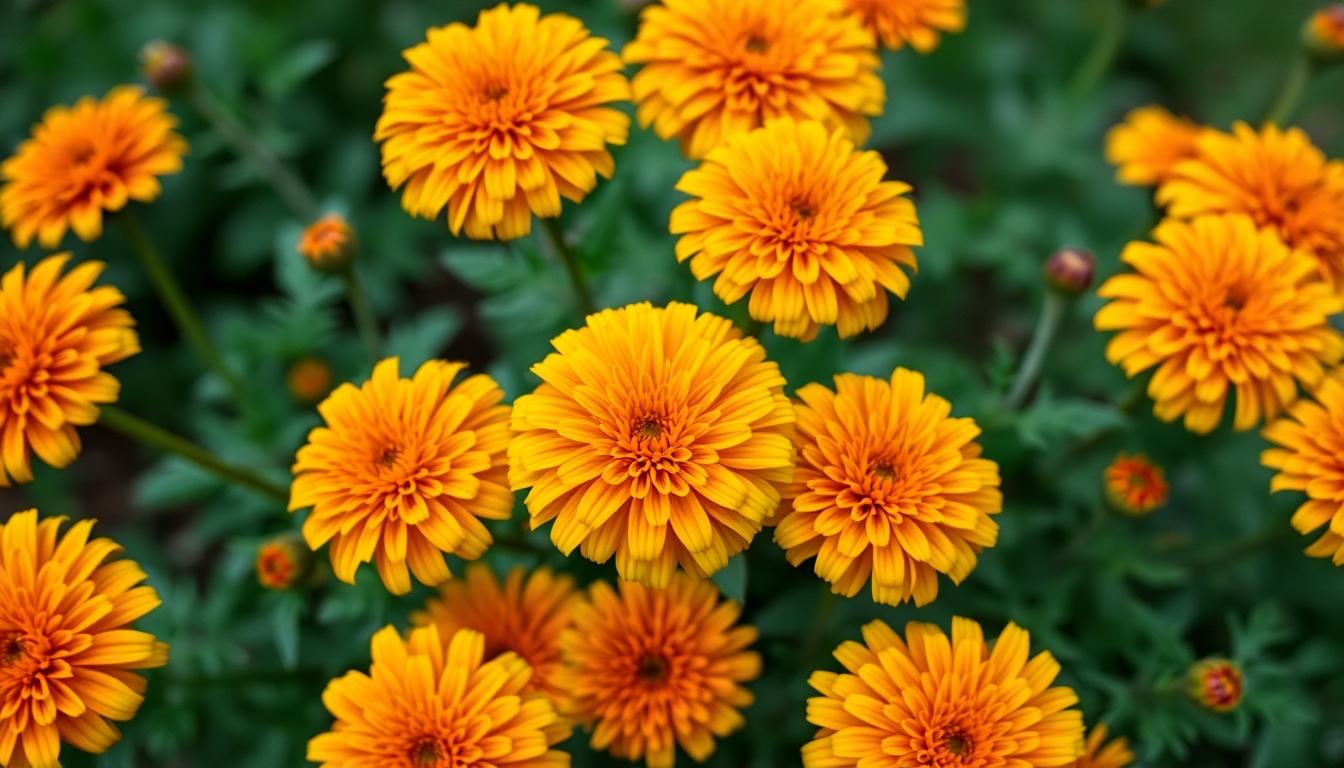
The Power of Marigold Pigments
Marigolds contain a powerful natural pigment called lutein that gives these flowers their characteristic vibrant yellow and orange hues. This same compound is responsible for the yellow color in egg yolks, making it a familiar and safe pigment. Tagetes erecta varieties are particularly potent sources of this natural colorant, offering rich golden tones that can be extracted with simple processes. Beyond their ornamental value in gardens and cultural ceremonies, these abundant flowers provide a sustainable alternative to synthetic dyes that often contain harmful chemicals.
How to Extract Marigold Dyes
Creating natural dyes from marigolds involves a straightforward process that anyone can perform at home. First, collect fresh marigold petals in a quantity equal to the weight of the fabric you plan to dye. Next, place the petals in a pot with enough water to fully submerge your fabric. Simmer this mixture for 30-60 minutes until the water transforms into a rich golden color. Then, remove the spent petals using a strainer and return the dye bath to heat. Finally, add your pre-moistened natural fabric to the dye bath and simmer for additional time to achieve your desired color intensity.
Color Range and Fabric Applications
Marigold dyes offer an impressive spectrum of colors ranging from pale lemon yellows to deep sun-drenched golds. Natural fibers like cotton, wool, and silk accept these dyes most effectively due to their ability to bond with plant-based pigments. For deeper colors, we recommend allowing your fabric to soak in the dye bath overnight after the initial heating process. Different mordants (fixing agents) can also alter the final color, creating variations from bright yellow to rich amber tones, expanding the creative possibilities for natural fabric artists.
Environmental Benefits of Marigold Dyes
Using marigolds as dye sources represents a important step toward more sustainable textile practices. These dyes are completely biodegradable and non-toxic, unlike many synthetic alternatives that release harmful chemicals into waterways. The cultivation of marigolds requires minimal resources, making them an accessible option for small-scale and commercial dye production. Their potential antimicrobial properties may even extend the life of fabrics, providing an added benefit beyond their beautiful colors.
Care and Maintenance of Marigold-Dyed Fabrics
Fabrics colored with marigold dyes require thoughtful care to maintain their vibrancy. Always wash these textiles in cold water with mild detergent to prevent color bleeding and fading. Avoid exposing marigold-dyed fabrics to prolonged direct sunlight, as this can cause the natural pigments to break down over time. Hand washing is preferable to machine washing for delicate or deeply pigmented items. With proper care, the warm, sunny hues from marigold dyes can continue to brighten your textiles for many years.
Growing Tips to Maximize Marigolds’ Beneficial Properties
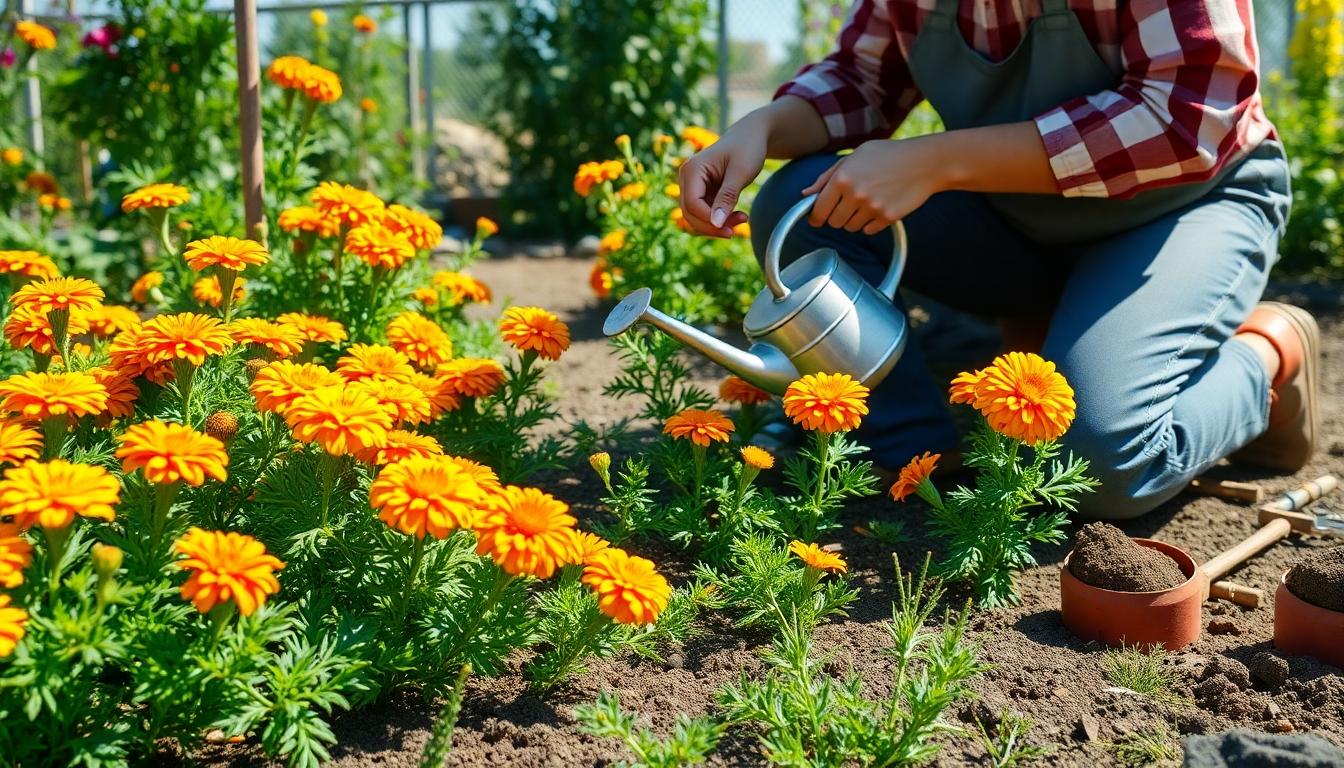
Cultivating marigolds with intention can significantly enhance their therapeutic and protective qualities. We’ve compiled essential growing strategies that ensure your marigolds produce the maximum amount of beneficial compounds like flavonoids and carotenoids. Follow these expert tips to unlock the full potential of these remarkable flowers in your garden.
Selecting the Perfect Growing Location
Marigolds thrive in environments that optimize their production of beneficial compounds. Full sun exposure is crucial for marigolds to develop their highest concentrations of medicinal properties. Choose a location that receives at least 6-8 hours of direct sunlight daily to encourage robust growth and maximum flower production. Good air circulation also helps prevent fungal issues that can compromise the plant’s health and beneficial qualities.
Creating Optimal Soil Conditions
The foundation of healthy, potent marigolds begins with proper soil preparation. Well-draining soil prevents root rot and creates the ideal environment for marigold roots to absorb nutrients efficiently. Aim for a slightly acidic to neutral pH (6.0-7.0) for optimal growth. Adding organic matter improves soil structure while providing nutrients that enhance the plant’s production of therapeutic compounds. Avoid heavy clay soils that retain excessive moisture, as this can dilute the concentration of beneficial compounds in the plants.
Mastering Watering Techniques
Proper moisture management directly impacts the potency of marigolds’ beneficial properties. Water marigolds at the base rather than overhead to prevent leaf diseases that could compromise their medicinal value. Regular, moderate watering encourages steady growth without diluting the plant’s essential oils and compounds. During flowering stages, maintaining consistent moisture levels helps marigolds produce flowers with higher concentrations of antioxidants and anti-inflammatory substances. Allow the soil to dry slightly between waterings to encourage stronger root development and more concentrated beneficial compounds.
Temperature Considerations for Maximum Benefits
Marigolds produce their most potent medicinal compounds when grown in their preferred temperature range. These versatile plants thrive in warm conditions between 70-85°F (21-29°C) but can adapt to various climates. Sudden temperature fluctuations can stress the plants and reduce their production of beneficial substances. Protection from extreme heat helps maintain the quality of their therapeutic compounds, particularly in regions with scorching summers. Growing marigolds during their optimal seasonal windows ensures they develop their full complement of healing properties.
Strategic Fertilization Approaches
Contrary to many flowering plants, marigolds produce more concentrated beneficial compounds when not overfed. Light fertilization with organic materials promotes balanced growth without diluting their medicinal properties. A slow-release, low-nitrogen fertilizer applied once monthly during the growing season provides sufficient nutrients without excessive foliage growth. Excess nitrogen can reduce flower production and diminish the concentration of therapeutic compounds. Organic amendments like compost tea can enhance the plant’s natural ability to produce flavonoids and carotenoids with proven health benefits.
Harvesting Methods for Maximum Potency
The timing and technique of harvesting significantly impact the therapeutic value of marigold flowers and leaves. Collect flowers in mid-morning after dew has dried but before the intense midday heat, when their beneficial compounds are most concentrated. Harvesting regularly encourages continued flowering and production of medicinal substances throughout the growing season. Fresh flowers contain higher levels of volatile compounds with antimicrobial properties, while properly dried flowers maintain their anti-inflammatory agents. Using clean, sharp scissors prevents damage to the plants and preserves the integrity of their beneficial properties.
How to Integrate Marigolds Into Your Sustainable Garden Plan
Marigolds truly are nature’s secret weapon for gardeners seeking sustainable answers. These vibrant flowers work tirelessly as pest deterrents pest controllers soil healers and even offer medicinal and culinary benefits beyond our expectations.
By strategically incorporating marigolds throughout your garden you’re not just adding pops of color – you’re building a robust defense system that protects valuable crops from harmful pests and soil pathogens without chemicals.
We encourage you to experiment with different marigold varieties in your garden spaces. Whether as companion plants border protection or rotating cover crops these versatile flowers deliver multiple benefits while improving your garden’s beauty.
Start with just a few marigolds this season and watch as they transform your gardening experience with their remarkable protective powers. Your plants your soil and your sustainable gardening goals will thank you.
Frequently Asked Questions
What makes marigolds effective as pest deterrents?
Marigolds contain compounds like alpha-terthienyl and sulfur that naturally repel garden pests. Their strong scent masks the smell of neighboring plants, deterring insects like aphids and whiteflies. Additionally, their roots release biofumigants that can reduce nematode populations by up to 90% when used as a cover crop, effectively cleansing the soil of harmful pathogens.
Which marigold variety is best for pest control?
French marigold varieties (Tagetes patula) offer the strongest pest-repelling properties. They’re particularly effective against root-knot nematodes and soil pathogens. When placed near the root zones of valuable plants, French marigolds create an underground defense system that protects against harmful organisms while still providing the colorful blooms marigolds are known for.
How should I use marigolds for companion planting?
Plant marigolds around the perimeter of vegetable gardens or intersperse them between vulnerable crops. They work especially well with tomatoes, cucumbers, eggplants, potatoes, and leafy greens. For maximum effectiveness against nematodes, grow marigolds as a preparatory crop before planting vegetables. You can also place them strategically around ornamental plants like roses and lavender to enhance protection.
Do marigolds have medicinal properties?
Yes, certain marigold varieties like Calendula officinalis have scientifically proven medicinal benefits. They possess wound-healing capabilities and anti-inflammatory effects, making them valuable in skincare. Calendula extracts enhance skin hydration and firmness, while Tagetes marigolds contain flavonoids that reduce oxidative stress. Research also suggests potential benefits for digestive issues, immune health, and even lowering blood sugar and cholesterol levels.
Can marigolds improve soil health?
Absolutely. Marigolds enhance soil structure with their deep root systems that aerate compacted soil and improve water infiltration. They support beneficial microorganisms and boost nitrogen levels, contributing to better nutrient cycling. When incorporated into garden rotation plans, marigolds significantly enhance soil health while reducing the need for chemical interventions. Their biofumigant properties also help cleanse soil of harmful pathogens.
Are marigolds edible?
Yes, certain marigolds are edible and offer unique flavors for both sweet and savory dishes. Pot marigolds (Calendula) have a slightly peppery, saffron-like taste, while French marigolds offer more citrus notes. Only use culinary-grade marigolds grown without pesticides. The vibrant petals can garnish salads, flavor quiches, or add color to desserts. Always remove the bitter white base of the petals before consuming.
Can marigolds be used as natural dyes?
Marigolds make excellent natural dyes, providing vibrant yellow and orange hues due to their lutein content. The extraction process is straightforward—simply simmer the flowers in water and strain. This creates a sustainable, biodegradable alternative to synthetic dyes that works well on natural fabrics like cotton, wool, and silk. The colors are typically vibrant initially but may fade with washing.
What growing conditions maximize marigolds’ beneficial properties?
Plant marigolds in full sun (6+ hours daily) to maximize their beneficial compound production. They prefer well-draining soil with a pH between 6.0-7.0 and moderate watering—letting the soil dry slightly between waterings. Marigolds thrive in warm temperatures (70-75°F) and benefit from light fertilization. For maximum potency of their protective compounds, harvest flowers mid-morning after dew has dried.







